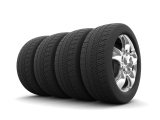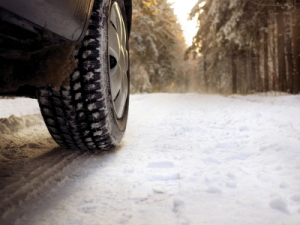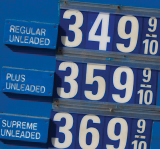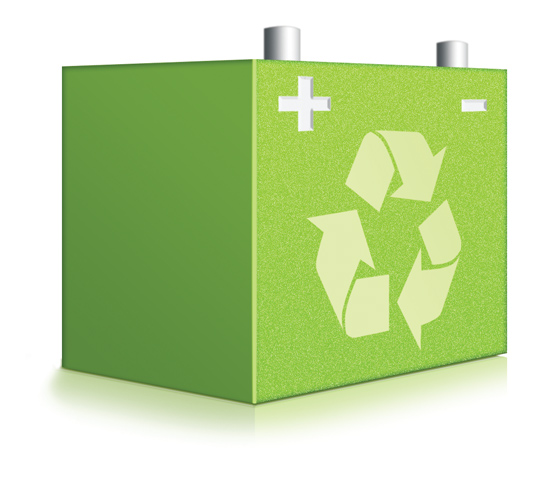
The Car Care Council |
 |
HOW TO CHOOSE THE RIGHT TIRES FOR YOUR VEHICLE
 |
Having the right rubber hoops wrapped around your car’s wheels is more important than you think. Tires are a vital component of car safety, and their importance is often overlooked. “Tires are the only four things touching the ground on your vehicle, and they impact everything whether it’s braking, turning, accelerating or wet driving,” explains Duane Sampson, Brand Manager for Yokohama Tires. |
Because they complete that essential link between your car’s suspension and the road, tires are responsible for translating the driver’s intentions directly towards vehicle performance. A quality set of tires will offer the responsiveness necessary for obstacle avoidance, short stopping distances that aid panic braking situations, and road holding grip under both dry and wet conditions. “There’s not a single component on a vehicle that contributes more to safety than tires,” says Kurt Berger, Manager for Consumer Products Engineering at Bridgestone.
Considering that quality tires can make the difference between stopping safely and hitting a car in front of you at 30 mph, let’s take a look at a few key questions that typically surround tire purchases and maintenance.
What kind of tire should I look for?
Tire shopping can be a daunting task, especially considering recent technological advances and the proliferation of sub-specialized tire genres. “Tires are asked to do a lot more today than several years ago due to the evolution in vehicle designs,” says Lori Simonelli, Senior Director of Technical Services at Toyo Tires.
But before you get bogged down by tire types be sure to find the right fitment for your vehicle. “You’ll want to confirm size, speed rating and load carrying capacity,” explains Kurt Berger, Manager for Consumer Products Engineering at Bridgestone. “We strongly recommend that replacement tires meet all of the specifications of the original tires.”
Once you’ve got the specs down you’ll be able to consider more nuanced variables. “Before making your purchase have a list of priorities whether it’s wear, longevity, performance or price,” adds Sampson.
You’ll then want to ask yourself some questions regarding your tastes and driving style. Do you need winter tires? How important is comfort for you? A tire professional will be able to help narrow down your choices based on what you want. There are three overarching categories of tire: summer, all season and winter. Within those you’ll find various performance levels to suit driving conditions. And of course, SUV and light trucks can be clad with off road, all terrain, highway, or highway all season tread patterns.
Should I spend extra for premium tires?
Simonelli says that “premium tire products are generally manufactured using higher standards whether through design and testing, casing construction, effectiveness of their design for a specific application, ability to balance (consistency), stability and wear resistance. Going with a lesser tire is not the wisest choice.”
As if that isn’t enough to sway you, Simonelli notes that, “Ultimately, premium products are often a better value due to their performance, expected mileage, customer support and warranties.”
What technology comes with top dollar rubber?
So you’ve decided to invest in quality tires? Great! You’ve opened the door to countless cutting edge, high tech features. Having the right rubber hoops wrapped around your car’s wheels is more important than you think.
For instance, Yokohama’s so called Advanced Inner Liner not only enhances performance and fuel efficiency by reducing rotating mass, the feature also minimizes air loss which, in the long run, can enhance tire longevity. Toyo’s Silent Wall system significantly reduces road noise while Continental’s Extreme Contact DWS tires feature novel indicators with lettering that disappears when it’s no longer safe to drive under certain conditions. When tire wear makes it unsafe to drive in the rain, the letter “W” disappears from the tread. Similarly, “S” indicates snow worthiness and “D” reflects when there’s sufficient rubber for dry traction. Run flat tires also cost a premium, but save the weight of a spare tire and reduce the risks associated with changing a flat by the roadside.
What about green tires?
Eco-consciousness means more than fuel economy improvements, and Yokohama has made their tires ecologically friendly by using citrus based orange oil, a renewable resource which enables petroleum to be replaced with natural rubber. The compound has been used in the Yokohama only IMSA GT3 Cup Challenge race series as well as on the ENV R-2 line of street tires.
Protecting your investment… and your safety
So, you’ve installed your new set of tires. What next? You’ll want to protect your investment with a proper four wheel alignment, and read your owners manual to check for rotation intervals. Your tire pressure, which can also be found in the owners manual, in the door jam or inside the fuel filler cap, should be checked regularly, and you should keep an eye open for uneven wear which can reflect an alignment or shock issue.

WHAT ARE THE DIFFERENCES BETWEEN THE GAS GRADES YOU PUT IN YOUR CAR?
| With gas prices reaching for the clouds you may be tempted to go for the lower grade when it’s time to top off the tank. For most of the motoring world that’s not a problem, but what about the rest of the cars out there whose owner’s manuals call for mid-grade or high test? While you may see an immediate savings at the pump running your engine off of a fuel other than what the manufacturer recommends will end up hurting you in the long run. |  |
Everyone knows that gasoline is made from crude oil. The Texas Tea is pumped out of the ground and sent through a refinery where it gets cracked into everything from natural gas to road tar. Gasoline sits somewhere in between those two extremes and, in its first state, what’s called straight run gasoline, has an octane rating of about 70.
Gasoline is given a grade by the American Society for Testing Materials (ASTM) based on how much it can be compressed before it explodes. Technically, this is called the “anti-knock index” and is displayed on huge yellow stickers next to the pump handle. The lower the grade, the lower the pressure it has to be under before it goes pop.
The number on your gas pump is the average of two different tests. The first is a laboratory based test called the Research Octane Number (RON). The second is the results culled from actual road conditions called the Motor Octane Number (MON). If you are an observant consumer you may have noticed the (RON+MON)/2 formula below your gas rating.
The grade, 87 for example, sits on a scale from zero to 100. Zero is the equivalent of a crude oil product called heptane which auto ignites under very little pressure. On the
opposite end of the scale, isooctane represents 100 and takes considerably more pressure before exploding. For instance, low grade gasoline has the same octane rating as 87 percent isooctane and 13 percent heptane.
Since straight run gasoline has such a low octane rating, petroleum engineers incorporate a number of additives and other agents to raise the fuel’s anti-knock index. The fuel that you find at your local station is actually a mixture of several different chemical compounds and may include everything from gasoline to detergents and what are referred to as oxygenates to clean your engine and reduce knock.
So why should you care how much fuel you can compress into a smaller space?
Engineers discovered a long time ago that an easy way to boost a vehicle’s power is to increase the engine’s compression ratio, or how much pressure the engine’s internals place on the air and fuel inside before igniting it. Cars that require mid-grade or high test gasoline put higher pressure on the air and fuel mix inside their engines than vehicles that only require low grade.
By now, you’re probably getting an idea of what happens when you run low grade gasoline in a vehicle that calls for high test. As the engine compresses the air and fuel mix it explodes before it’s supposed to. This is typically referred to as “ping” or “knock” and can lead to problems. Premature spark plug failure, loss of engine power, low mileage and engine damage leading to oil consumption are just a few.
Unfortunately, there is no magic number that determines what compression ratio needs at what octane level. It depends on a huge number of factors figured out by engineering interns in dark cubicles for car manufacturers everywhere.
As for running high test in a vehicle that only requires 87 octane, the impacts are mostly monetary. The car will merrily chug along, bleeding your bank account dry. According to most sources, higher octane is no cleaner for your engine than the low grade stuff. That said, if your 87 sipper seems to be knocking more than usual, stepping up a grade may solve the problem.
You may have noticed a few gas stations now proclaim a portion of their fuel is made up of ethanol. Right now, most vehicles can run up to 10 percent ethanol in their fuel without voiding the warranty. That percentage usually replaces the standard anti-knock additive portion of your gasoline mix working as a cleaning agent inside your engine as well. As an added bonus, most ethanol is produced here in the U.S. by sweat-of-their brow farmers, so you can feel a little better about yourself when the pump reads $50.
While jumping down a few grades may save you a buck or two at the station, the loss of fuel economy and potential damage to your engine isn’t worth it. Bite the bullet, reach for what your car calls for and squeeze the trigger. If you don’t, you’ll be sentencing your ride to a slow death one tank at a time.
CAR BATTERIES RECYCLED BY 98 PERCENT OF AUTOMOTIVE AFTERMARKET COMPANIES
A car battery can lead a long and productive life but, sooner or later, this important part of the vehicle’s starting and charging system will need to be replaced. When the time comes to say goodbye to your car battery rest assured that it’s being recycled by 98 percent of automotive aftermarket companies including auto repair shops, manufacturers, distributors, retailers and jobbers according to a study by the Automotive Aftermarket Industry Association (AAIA).
As a result of these efforts, an estimated 65 million automotive batteries were recycled in 2010, equal to 1.5 billion pounds of lead, according to AAIA’s Aftermarket Factbook.
“Battery recycling is just one of many ways automotive aftermarket companies contribute to a cleaner environment,” said Rich White, executive director, Car Care Council. “These businesses have been ‘green’ long before being ‘green’ was mainstream.”
More than 95 percent of an automotive battery can be recycled. The lead, plastic, acid and sulfuric acid found in batteries are reclaimed and reused in the manufacturing of new batteries.
The lead is cleaned and melted and used in the production of new lead plates and other parts for new batteries. The plastic is cleaned and melted into pellets used to manufacturer new battery cases. Old battery acid can be neutralized into water which after treatment, cleaning and testing, can be released into the public sewer system, or it can be converted into sodium sulfate and used in laundry detergent, glass and textiles.
In addition to recycling batteries, automotive aftermarket companies recycle tires, used oil and oil filters, parts, cleaning solvents, scrap metal, plastics, cardboard and paper, a/c refrigerant, dunnage and wood pallets.
